By SERGEY KADINSKY
Forgotten NY correspondent
In the section of Queens Village to the south of the train tracks where Springfield Boulevard meets Hollis Avenue is a remarkable building: the John Harvard P. S. 34, built in 1897. Its Flemish Renaissance appearance is similar to that of Newtown High School in Elmhurst, both designed around the same time by prolific public school architect CBJ Snyder. While the latter is an official city landmark, the one here does not have the appreciation of the city’s cultural officials.
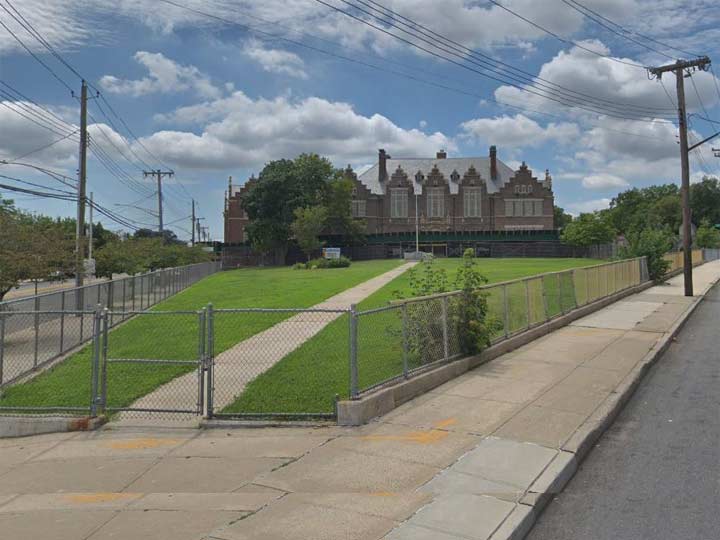
When the school was built much of the surrounding area was farmland sprinkled with residences dating to the colonial period. Known historically as Little Plains, the terrain here was wide open as the eastern edge of the larger Hempstead Plains, a post-glacial grassland that once covered 60,000 acres between Queens Village and the Suffolk County border. Its flatness made it an ideal place for farming, grazing, horse racing, and early aviation.
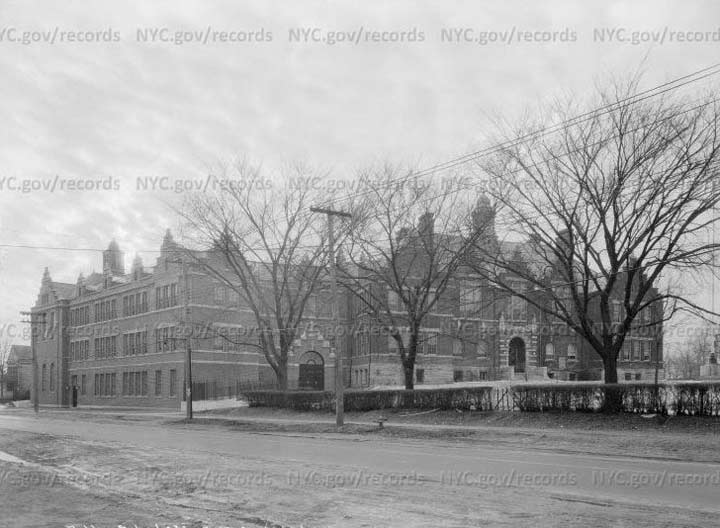
Following the completion of the railroad tunnel to Penn Station in 1910, suburban development in Queens Village rapidly picked up. With more students signing up, the school expanded with a wing facing Springfield Boulevard. But instead of grafting an Art Deco or Moderne design to the wing, the architects faithfully continued with Flemish Renaissance of the original building. Nothing looks uglier than having a modernist addition to a historicist building. Perhaps it is in a nod to its appearance that this school is co-named after the founder of the country’s most prestigious university. Snyder’s designs were meant to evoke higher learning to inspire public school students.
My own alma mater, PS 139 in Rego Park has a Snyder-designed core with a non-matching 1960 gym/auditorium wing. Fortunately in the late 1990s, the kindergarten wing was given matching red bricks and cornice line of the original design.
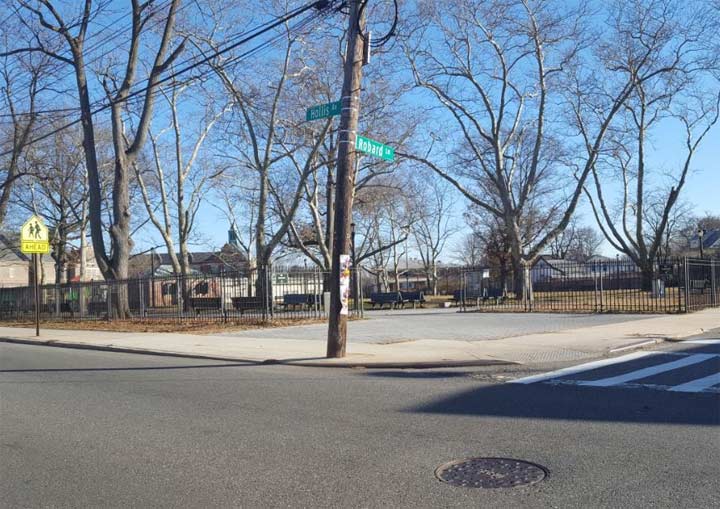
Behind P. S. 34 is the 2.5-acre Wayanda Park, which features a lawn, playground, handball and volleyball courts. The park’s lawn has a morbid past as the Town of Jamaica Potter’s Field, authorized for such use in 1844. In contrast to the Olde Towne of Flushing’s Burial Ground, this one never received its proper respect. An 1872 report notes that the paupers and criminals buried here do not have tombstones. With no visitors to pray for the deceased, in 1908, local residents petitioned the city to designate the property as a park. It opened in 1912 as Wayanda Park, taking its name from the Native term “place of happy hearts.” I am not sure who found this translation proper as the Iroquian Wyandot nation is thought to mean “dwellers on a peninsula.” There’s also Wyandanch on Long Island, the translation of this term apparently lost to history.

In 2002, human remains were found under the park and in the following year a Cultural Resource Survey was conducted in the park in search of further remains. In contrast to the Flushing burial ground, which received a historically-themed reconstruction between 2004 and 2009, Wayanda’s appearance has not changed since 1970 when an annex of PS 34 was built on the edge of the park. This single-story structure has none of the school’s Flemish flair, resembling a trailer in its appearance.

Across Hollis Avenue facing the park is the Roman Catholic Church of Saints Joachim and Anne. Founded in 1896, its membership today is largely comprised of Haitian immigrants. I am fascinated by the church’s stained glass windows, which resemble those on the Great Hall at the New York Hall of Science. The namesake saints are the grandparents of Jesus, born through their daughter Mary. As these two saints predate Jesus, I’ve wondered why Christianity doesn’t refer to earlier biblical figures as “St. Abraham,” or “St. Moses?” Why isn’t their defining prophet referred to as “St. Jesus?” I’m certainly not an expert in Christian nomenclature, comments are welcome to explain it to me.

Being so close to the city line, I took a quick jog to the Queens-Nassau border on Hempstead Avenue, also known as NYS Route 24. At Belmont Park, the border is very clear. There’s a Nassau County sign, change in paving, and lamppost design. But the real gem here is the underpass below Hempstead Avenue that straddles the borderline.

Prior to 1958, this tunnel was used by the Belmont Park branch of the Long Island Railroad. Trains terminated on the southern side of the road, close to the village of Elmont. In 1957 the station was relocated to the north side of the road, closer to the grandstand.
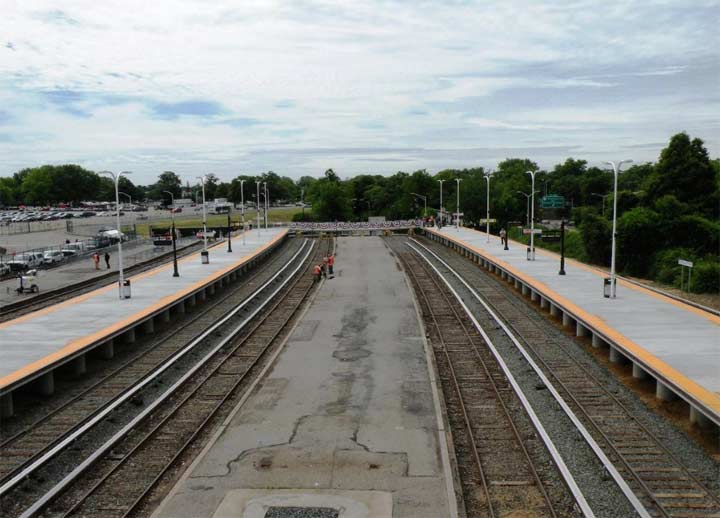
While the horse racing track is entirely in Nassau County, the station is within the border of Queens. For decades local leaders have been pushing to make Belmont Park a commuter station, but the railroad and the racetrack continue to argue that there is not enough capacity on the Main Line to accommodate a new branch. For now, residents of Elmont must take their cars or a bus to Queens Village to catch the train.
[When the new hockey stadium for the Islanders is built adjacent to Belmont Park, a new connection to the main line will have to be built. — Ed.]

The development of Hollis and Queens Village was in piecemeal fashion, with subdivisions surrounded by farmland, and eventually they expanded toward each other. Many of these early developments had sidewalk gates as seen here on 115th Avenue.

The piecemeal development of former farm properties also resulted in the laying of streets that did not line up with each other, resulting in repeated numbering and preservation of names in some cases, as in Robard Lane that borders on Wayanda Park. As seen above in the 1918 Belcher-Hyde atlas.
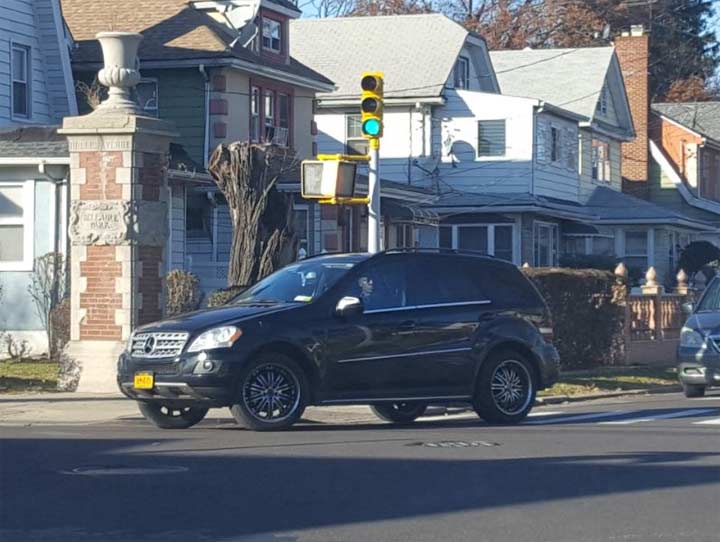
Another such development is Bellaire Park, which has a more detailed history. In 1900, a property south of the tracks opened to the public as Interstate Park, operated as a casino and shooting range operated by the National Trapshooting Association. At its annual Grand American tournament, flying birds were released from their cages and shot by trained marksmen. Even in those days the concept of releasing a bird from it cage and killing it as it flies for freedom was highly unpopular. The state banned this sport two years later and the shooting range went out of business. Interstate Park was sold for residential development in 1906 and renamed Bellaire.
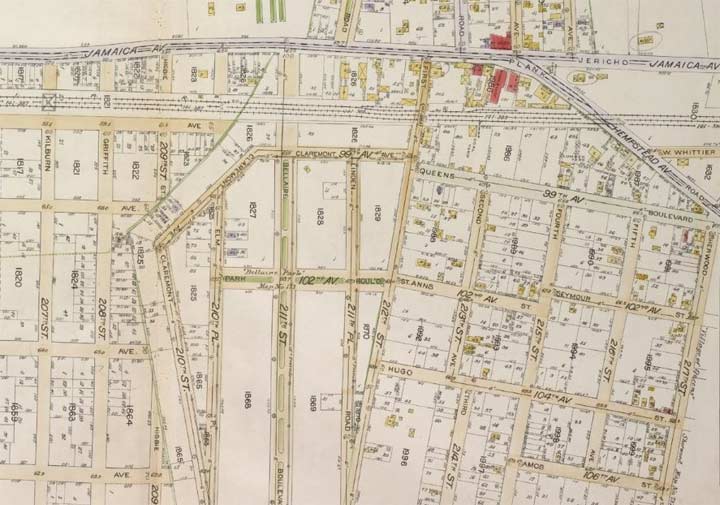
As the 1918 Belcher-Hyde map shows, Bellaire was two blocks in width, with a boulevard running down its middle. In compliance with the borough-wide numbering grid, Bellaire Boulevard was renamed after 1911 as 211th Street.

The green medians on this road are maned as a linear park named Mall 211. Note that in Queens Village there was a four block-long Queens Boulevard. To avoid confusion with the much lengthier Queens Boulevard in western Queens, this was numbered as 99th Avenue.
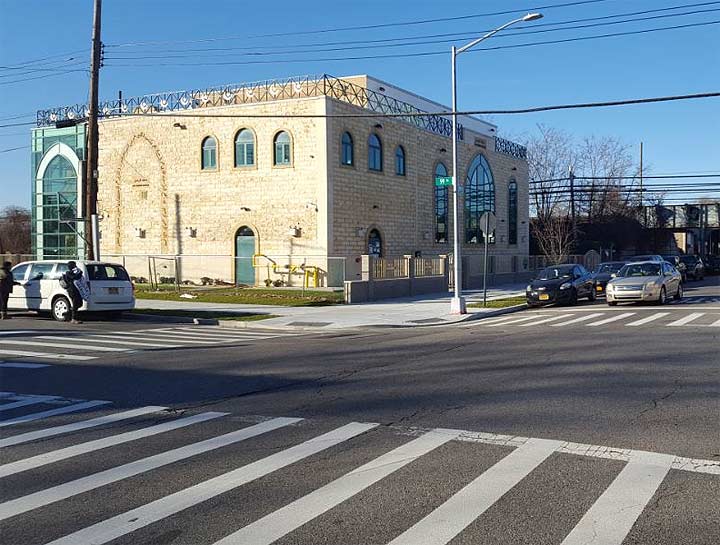
At the underpass of 211th Street and the Long Island Railroad we see metal protrusions on the trestle indicating remnants of a platform. Prior to 1972 this was the Bellaire station on the Hempstead Branch. It closed due to lack of ridership and proximity to the Queens Village station. On this block the Ar-Rahman Mosque piqued my attention. Its yellow brick design is reminiscent of the architecture in Israel and the Palestinian territories, where Jerusalem stone is the preferred building material. I couldn’t take the train home from here, but this is where I’m ending my slice of Queens Village.
If you wish to see more of this neighborhood, have a look at Kevin’s essays. He has an 1852 map that shows the intersection at P. S. 34 as having a long history. In 2005, he took the train to Queens Village. Then in 2011, he walked on Jamaica Avenue from downtown Jamaica to Queens Village.
Our biggest source of pride in Queens Village is the .074-acre Litchhult Square, a tiny park whose namesake was all but forgotten. As a result of our page on this tiny park, two Litchhult descendants emerged to tell the family’s connection to this park and the namesake turned out to be Lt. Andrew Slover Litchhult (1895-1936).
Sergey Kadinsky is the author of Hidden Waters of New York City: A History and Guide to 101 Forgotten Lakes, Ponds, Creeks, and Streams in the Five Boroughs (2016, Countryman Press) and the webmaster of Hidden Waters Blog.
Please help contribute to a new Forgotten NY website
Check out the ForgottenBook, take a look at the gift shop, and as always, “comment…as you see fit.”
1/4/19

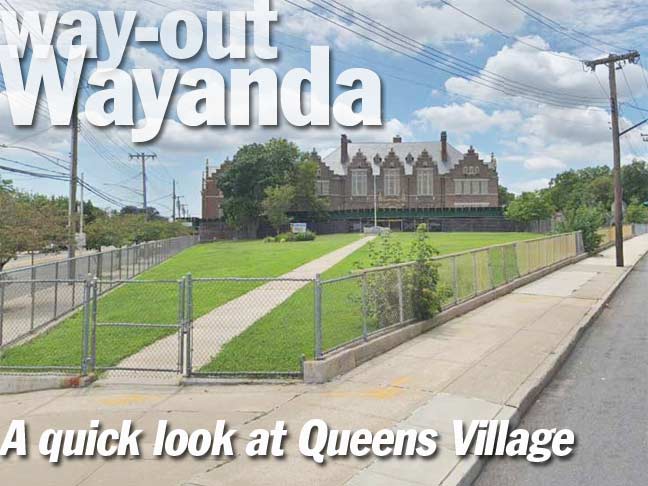
28 comments
Live pigeon shooting has mostly but not entirely disappeared from the United States. A few clubs in Pennsylvania still sponsor it.
Saints Joachim and Anne have an unusual place in Christian theology. They’re not mentioned anywhere in the Gospels, only in some early writings of questionable authenticity. As I understand it, the idea is that Mary must have had parents, so Joachim and Anne are as good names as any.
Terra (mostly) incognita. I lived in the north end of town, across Union Turnpike from Bayside. I did have some friends in 29, but their families all beat feet out to Long Island when the block busters started moving in.
I lived in the Bellaire section of QV growing up, and found this very interesting. My dad walked to work on Jamaica Avenue, where he and my grandfather owned Dehler Body Shop for many years, which is of course gone with a big car dealership there now.
Thank you for this great information!
Mr. Dehler’s auto shop was well-known in our
neighborhood.
We lived on 214th St. and were friendRicciardi.
Ricciardi family on 213th.
Mr. Dehler lived next door to the Ricciardis.
(We were friends with the Ricciardi family.)
Thank you for this wonderful trip back to my childhood!!
Starting in 1947 to 1956, my sister and I attended SS Joachim and Anne school and walked there and back every day from 101-41 223rd St. Most of our friends attended PS 34 and didn’ have to wear uniforms, but I was always grateful for the excellent education I received from the good nuns of the Order of Norte Dame. From high school, Bishop Mc Donnell in Brooklyn, to graduate school, I excelled because of their dedication to educating young minds. They were a cloistered order, meaning they were only allowed to go between the convent, the school and the church. We therefore got to run errands for them and were allowed entry into the huge hallway of the convent. There we inhaled the delicious odor of polish and awaited the list of what to purchase along with a cloth bag of money. It was considered an honor to be entrusted with these tasks and how I coveted the assignment!
Wonderful story. Perhaps the fact that the nuns at Sts. Joachim & Ann were cloistered helps explain the founding of Our Lady of Lourdes school just one mile away. The number of nuns in a cloistered order must have been small. With the demand for Catholic education in Queens Village growing, the Order of Notre Dame probably wouldn’t have been able to meet the need. BTW, I attended Our Lady of Lourdes school from 1947 -1953 when we moved away.
Did you know the Wells family they lived in the north corner house on 101 ave and 222 st
What happened to the church of Sts. J and A? I went there with my mother a long time ago. It seems to have been replaced with the current
modern building. I did religious instruction weekly with the fine nuns.
The new church was built ~ 1968. Old church sat vacant for a year or so and was eventually torn down ~1969
“Wyandanch” (or “Wyandance”) was one of the most famous Native Americans from Long Island. He was the sachem (or often called “king”) of the Montauket tribe in the 1600s, located in Montauk. In his time he was deemed the leader of all tribes on Long Island. He played a pivotal role in friendly relations with European settlers, most significantly Lion Gardiner (of Gardiner’s Island). Worth reading up on. It appears the application of his name to the locality was purely arbitrary, similar to “Manhasset,” the name of the tribe inhabiting Shelter Island being applied to the area in Nassau County.
I believe it should be WESTERN edge of the larger Hempstead Plains.
Sts. Joachim & Ann school is only one mile from Our Lady of Lourdes school, which I attended. It seems unusual to have two Catholic schools so close. There must be a story here.
Oh no! Kevin, we gotta correct this.
Interesting that Wayanda lies outside present day Hollis on Google Maps. Francis Lewis Blvd. is shown as the eastern border of Hollis.
Very nice. One other point of interest in this area would be the Queen of Peace Residence on 112th Avenue, east of Springfield Boulevard. If you look at the building from the aerial view, the architecture resembles the shape of the risen Jesus.
SS. Joachim and Anne School is celebrating its’ 95th Anniversary at the Immaculate Conception Center on Saturday June 1, 2019. I will post additional information as I receive it.
For those who believe, Jesus wasn’t a prophet, he was the Son of God and part of the Trinity, one God in three persons, Father, Son, and the Holy Spirit. Referring to Jesus as a prophet would be like calling Allah a prophet in Islam. Allah is God in Islam, not a prophet. Likewise, Jesus is God in Christianity, not a prophet. A prophet is a person regarded as an inspired teacher or proclaimer of the will of God. Prophets are not God.
Jesus also is God, not a saint. Saints are regular people, not divine, who are in heaven.
Got it. Thanks for the explanation. So to recap, saints are not prophets. That explains why we don’t write St. Moses or St. Solomon.
This ws truly a great way to bring back such great memories from my childhood. I lived in Queens Village at 105-12 223rd street until 1955. I attended P.S. 34 from Kindergarten to 8th grade. I can still remembering the flag pole and in May each year they would have a ceremony. One year I was actuallly the Queen and a boy in my class, Billy Nusbaum was the King. It is amazing that I can still remember his name and all my teachers names. Thanks for all the great pictures and stories.
You might remember m.y brother George or my Sisters Barbara or Martha oppermann
Hi Arlene, My name is Ray Kuhn. I went to P.S. 34, 1st to 8th grade and graduated in 1953. I lived on 220th street and 107th ave. I don’t think we were ever in
the same class, but I remember your name and you. I now live in the Seattle area. Nice to hear of a class mate. Ray Kuhn
I went to P.S.34 up till 6th grade then we went to P.S.134 in hollis for 7 and 8th grade
What happened to the earlier Church Sts Joachim and Ann? As a kid we went there most Sundays as well as Wednesday afternoons, walking from PS 134 (not 34). But the current church seems much more modern than the one of my memory.
Sometime in the 1960s, the old steepled church needed significant repairs and also was not big enough for the number of parishioners. It was torn down when the new church was built. I was confirmed and graduated grammar school (1958) from the old church. I heard that the statute of St. Anne that stood in front of the old church was moved to the new one. Unfortunately, it was vandalized and I am not sure of it was ever repaired. I think that the statue was in almost every First Holy Communion, Confirmation and Graduation picture for generations of SSJA students. Does any one know if the old convent remains? It was behind the school next to the playground where we lined up for class and took our recesses.
great article. I live a few blocks from the QV train station . Ive only been around here 10 years but the history and character of the nabe, part of “Greater Jamaica” grows on you.
QV feels like an extension of Jamaica Ave & Hillside Ave in Queens, , but you go one block east of the Cross Island Parkway and it feels / looks like a different world : “Long Island” not Queens . The only continuity between the 2 is Hillside Avenues “Little Punjab”
The racial divide of NYC black culture and Long Island white culture is stark . People in Floral Park are actually amazed that as a white guy i shop in Jamaica Queens . Like Garden City / Hempstead , theres a real cultural border . Amazing to think Nassau was once part of Queens County. When it divided, Nassau may be wealthier , but we have better drinking water in Queens
I went to P. S. 34 from 1st thru 8th grade, graduated in 1956
Muriel dugan I knew graduated from PS 34 in 1952 ….